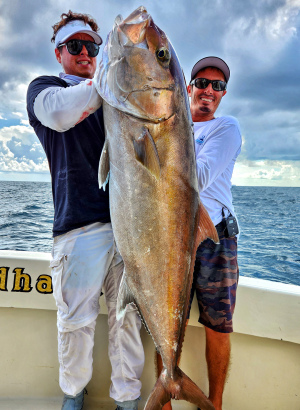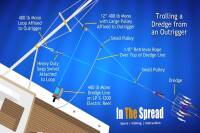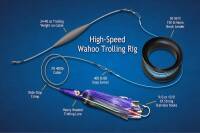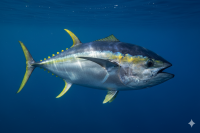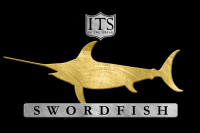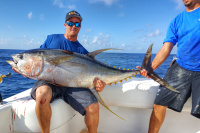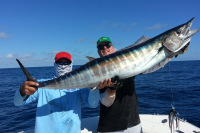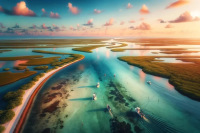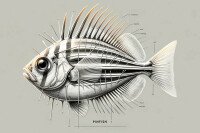Florida's cobia fishery offers year-round action for anglers targeting this powerful sportfish. Learn the seasonal migration patterns, prime cobia fishing locations from the Panhandle to the Keys, and most effective techniques including sight-fishing, jigging, and live-baiting. Get expert tips on tackle selection and strategies for landing these hard-fighting fish.
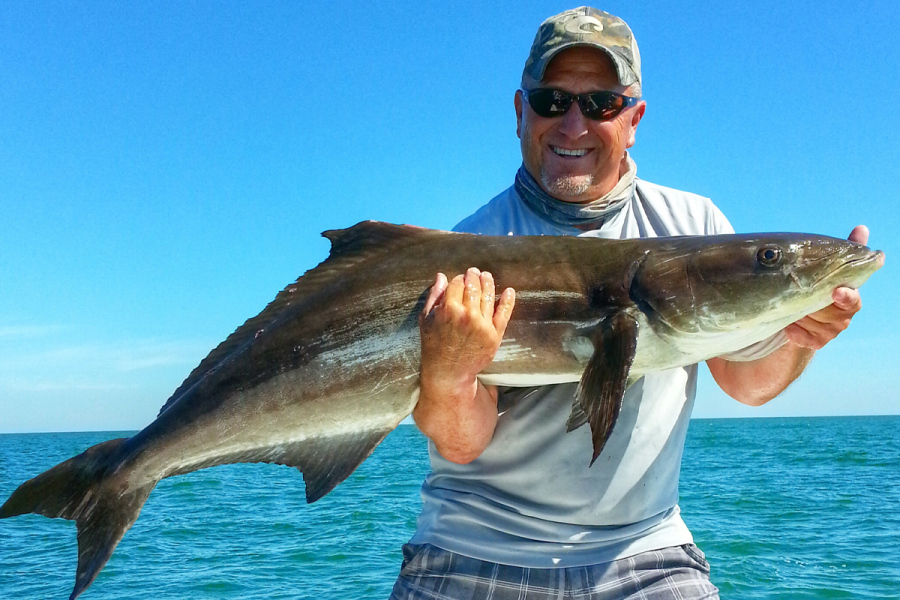
Cobia Fishing: A Florida Guide
Cobia Fishing in the Sunshine State
Cobia Biology and Behavior
Physical Characteristics and Identification
Feeding Habits
- Crustaceans: Crabs, particularly swimming crabs (portunids), make up a significant portion of their diet, found in up to 79% of examined cobia stomachs.
- Fish: As cobia grow larger, they become increasingly piscivorous. Common prey fish include:
- Hardhead catfish (a particular favorite, making up to 24% of their fish diet)
- Eels (up to 18% of fish consumed)
- Mullet
- Jacks and snappers
- Pinfish, croakers, and grunts
- Squid and Shrimp: These are eaten in smaller quantities compared to crabs and fish.
Typical Habitats
- Wrecks and artificial reefs
- Buoys and navigational markers
- Pilings, piers, and platforms
- Anchored boats and floating debris
- Sandbars and channels
- Large marine animals like manta rays, sharks, and even manatees
Seasonal Patterns and Migration
Cobia Migration Overview
- Winter (December-February): Cobia concentrate in the Florida Keys and southern Gulf waters, seeking warmer temperatures. The Keys serve as a wintering ground for both Gulf and Atlantic stocks.
- Spring (March-June): As waters warm to the preferred 68-72°F range, cobia begin migrating northward along both the Atlantic and Gulf coasts. This triggers the famous spring "run" along the Panhandle and Space Coast, where cobia move close to shore and become more accessible to anglers.
- Summer (June-August): Cobia remain available, especially in deeper Gulf waters and around offshore structures. Nearshore action is best earlier in the summer, while fish move deeper as water temperatures rise.
- Fall (October-November): A secondary peak occurs as cobia migrate southward, particularly along the Atlantic coast. Look for fish moving back toward warmer southern waters as temperatures drop.
Gulf vs. Atlantic Population Differences
- Gulf Population: These cobia migrate north-south within the Gulf, wintering in South Florida/Keys and rarely moving up the Atlantic coast beyond Cape Canaveral.
- Atlantic Population: These fish migrate north-south along the Atlantic seaboard, with major spawning in the Mid-Atlantic, and rarely enter the Gulf.
- Mixing Zone: The populations meet around Cape Canaveral, not the Keys as once thought. Fish south of Cape Canaveral are mostly part of the Gulf population.
Water Temperature's Role in Migration
Top Destinations for Cobia Fishing in Florida
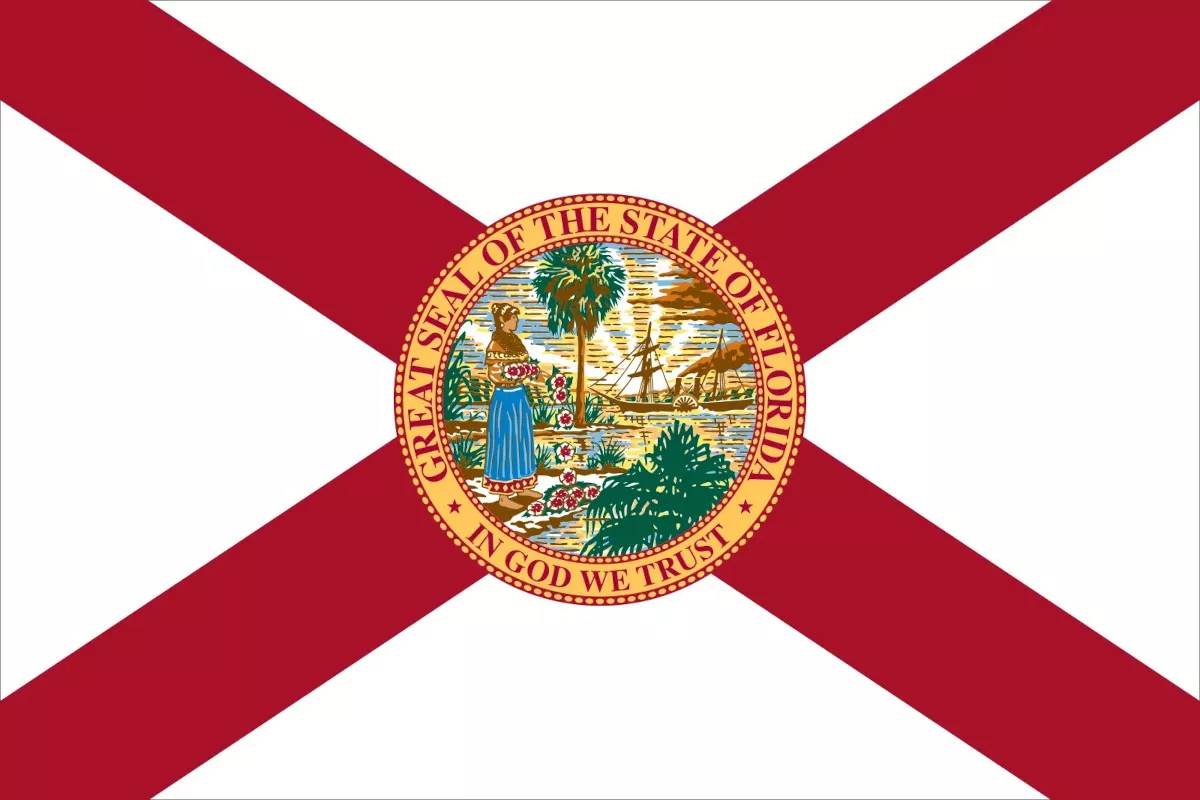
Destin and the Florida Panhandle
The Panhandle, especially around Destin, is legendary for its spring cobia run. Anglers flock here in March and April when cobia migrate along the beaches, making them visible for sight casting. The proximity of productive waters to shore means you can be on the fish quickly, and the region is renowned for both the size and numbers of cobia landed.
Crystal River and Florida's Nature Coast
Crystal River is a cobia hotspot thanks to its rich network of reefs, shipwrecks, and inshore structures. The area is famous for its clear waters and diverse habitats, making it ideal for both boat and kayak anglers. Cobia here often associate with manatees and rays, adding a unique twist to the hunt.
Tampa Bay and Charlotte Harbor
Charlotte Harbor is a top choice for inshore cobia action, especially in spring. Migrating cobia move along the sandbars and deep channels, often following rays and congregating near markers and bridges. The harbor's expansive flats and accessible structure make it a favorite for both boat and shore anglers.
The Florida Keys
The Florida Keys, especially around Key West and famous bridges like Long Key, are a winter and early spring haven for cobia. The clear waters and extensive reef systems attract both Gulf and Atlantic stocks, offering excellent opportunities for sight-fishing and jigging.
Atlantic Coast (Daytona to Jacksonville)
The Atlantic coast offers excellent opportunities during both spring and fall migrations. Sight-fishing is productive along beaches and inlets, with many fish following rays nearshore.
Techniques for Catching Cobia
Sight Fishing Cobia
- Position your boat and patrol beaches, sandbars, or areas with rays and sharks
- Use polarized sunglasses to spot cobia near the surface or following rays
- Cast well ahead of the fish's path (not directly at them)
- Use quick, erratic retrieves to trigger strikes
Spinning and Casting
- Rod: 7-8 foot medium-heavy to heavy spinning rod
- Reel: 5000-8000 size with smooth, strong drag
- Line: 30-50 lb braided line
- Leader: 40-80 lb fluorocarbon, 18-24 inches long
- Greater strength in a thinner diameter allows more line capacity
- Almost no stretch provides better hooksets and sensitivity
- Improved casting distance helps reach cruising fish
- Better abrasion resistance protects your line around structure
Jigging
- Focus on sandbars, flats, and nearshore structure where bait is being pushed in
- Use vertical jigging with big lifts and medium-paced retrieves
- Bucktail jigs and soft plastics in the 1-3 oz range work well
- Target deeper channels, inlet mouths, and down-current sides of structure
- Use heavier jigs (2-8 oz) to maintain bottom contact in stronger currents
- Try speed jigging with more aggressive motions to trigger reaction strikes
Chumming and Drifting
- Anchor upcurrent from productive structure like wrecks or reefs
- Create a chum slick using menhaden, sardines, or commercial chum
- Free-line live baits back in the chum slick
- Be prepared for multiple fish, as cobia often travel in small groups
- For eels: Through the back of the head
- For mullet and baitfish: Through the lips or shoulders
- For pinfish: Through the back just behind the dorsal fin or nose
- For crabs: Through the point of the shell or a leg socket
Fly Fishing
With the warming waters of mid-April I've heard some chatter about cobia showing up just offshore and even a few being caught on the flats while trout fishing. I catch most of my cobia by chance but I've always been prepared for them. A heavy spinning reel and 30lb. braid is my choice with a 60lb fluorocarbon leader. Large soft plastic swim baits, bucktails and Hogy eels are excellent artificials. For live bait it's hard to beat a large pinfish. I normally check markers, wrecks or high profile rocks to spot cobia on the surface. Another method is to chum one of these structures and bring the cobia to you. Incoming tide will be early morning or late evening this weekend.
Capt. William ToneyBest Baits and Lures
Live Baits for Cobia
- Live eels: Considered the premier live bait for cobia due to their enticing, slithering action
- Live crabs: Particularly blue crabs which are a staple in the cobia's natural diet
- Pinfish: Active, hardy, and a go-to bait for many Florida cobia anglers
- Juvenile mullet: Most effective in the 4-8 inch range
- Menhaden and threadfin herring: Oily and highly attractive to cobia
Cobia Lures
- Bucktail jigs: The classic cobia lure in bright colors like chartreuse, pink, orange, and white
- Soft plastic eels: 10-12 inch models work well when cobia are feeding on eels
- Heavy/speed jigs: 2-8 oz versions for deep water or strong current
- Topwater plugs: Effective for surface-feeding cobia
- Spoons and diving plugs: Best when baitfish are abundant
Hook Selection
- Circle hooks: Excellent for live baiting and catch-and-release fishing
- J hooks: Preferred by some for better hookup ratios in cobia's hard, bony jaws
- Assist hooks: For jigging, use robust, heavy-gauge versions that won't bend
Leader Selection
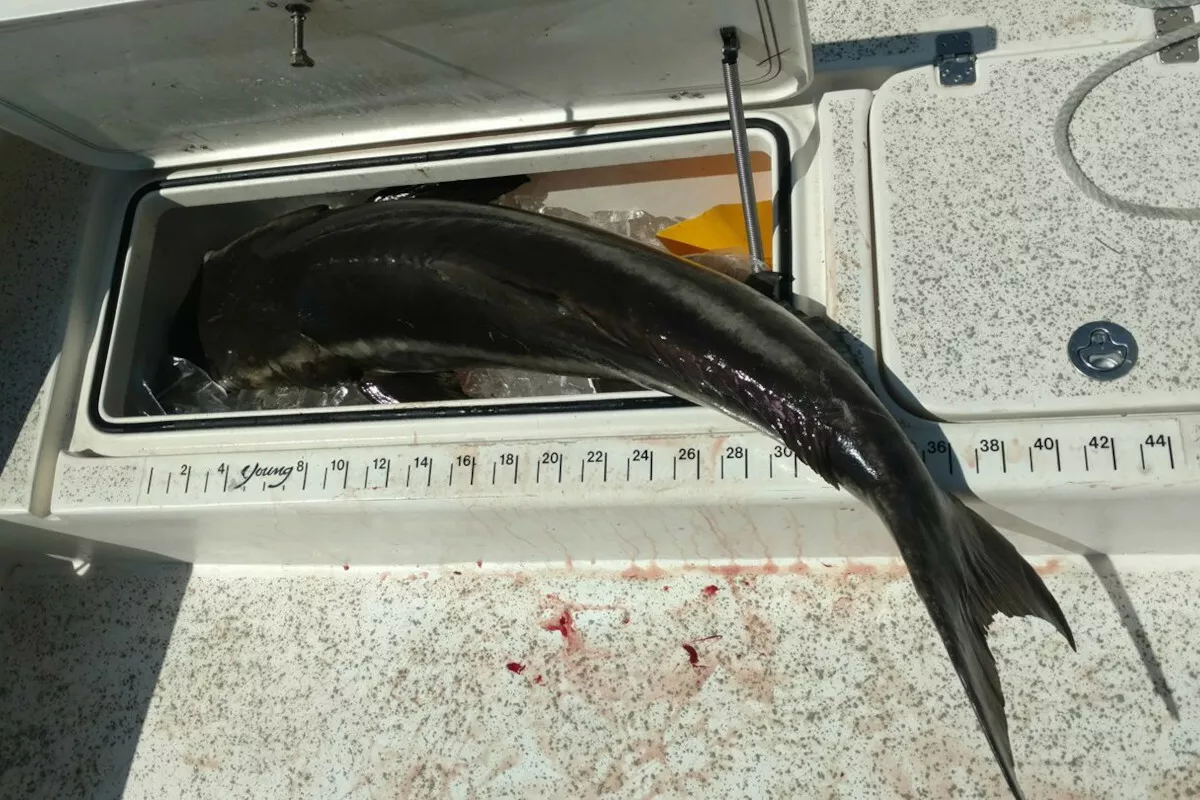
Productive Structures and Hotspots
Key Structures for Cobia
- Wrecks and reefs: Both natural and artificial options hold abundant baitfish
- Buoys and navigational markers: Among the most reliable cobia hotspots
- Pilings, piers, and platforms: Provide vertical structure that cobia patrol regularly
- Anchored boats and floating debris: Any large object that interrupts open water
- Sandbars and channels: Especially productive during spring migrations
Following Marine Life to Find Cobia
- Manta rays: The classic cobia companion, often with multiple fish following
- Sharks: Cobia frequently follow various shark species for cover
- Turtles: Sea turtles sometimes have cobia accompanying them
- Manatees: In some areas, cobia may associate with these gentle giants
Seasonal Structure Preferences
Cobia's structure preferences change throughout the year:
- Winter: Deep wrecks, reefs, and rock ledges in southern waters
- Spring migration: Nearshore structures like buoys, markers, and shallow reefs
- Summer: Deeper offshore structure that provides cooler water
- Fall: Similar to spring, but focusing on structure along southward migration routes
Weather, Tides, and Timing
Water Temperature Effects
- Ideal range: 68-73°F for active cobia
- Spring trigger: Beach runs typically begin when surface temperatures reach 68-69°F
- Summer pattern: As temperatures rise above mid-70s, cobia move offshore to deeper, cooler waters
- Post-front behavior: Cobia may become sluggish after cold fronts until conditions stabilize
Best Weather Conditions
- Falling pressure (warm fronts): Generally improves cobia activity and feeding
- Rising pressure (cold fronts): Tends to slow cobia down for a day or two
Tidal Influences
- Rising tides: Cobia may move onto flats and into bays following bait
- Falling tides: Fish often position themselves in deeper channels or near drop-offs
- Slack tide: Bait disperses and cobia activity drops significantly
Best Times of Day
- Early morning: Cooler temperatures and active feeding make dawn prime time
- Late afternoon: Pre-dusk feeding activity often triggers aggressive bites
- Midafternoon: Best for sight-fishing when the sun is high, improving visibility
Landing, Handling, and Safety
Fighting and Landing Techniques
- Let them run: Allow the initial burst while maintaining steady pressure
- Keep the rod tip up: Helps absorb sudden dives and maintains pressure
- Avoid horsing: Trying to muscle in large cobia often leads to lost fish
- Be patient: Larger specimens may require extended fights (20-30 minutes)
Rod and Reel Selection for Landing Big Cobia
- Medium-heavy rods (7-8'): Versatile and good for casting live baits
- Heavy rods (8-9'): Extra backbone for heavy jigs and controlling big fish
- Shorter rods: Better control in close quarters but sacrifice casting distance
- Size: 5000-8000 series spinning reels
- Drag: Smooth, strong system for handling sudden runs
- Line capacity: At least 200 yards of 30 lb mono or 300 yards of braid
Boat Handling and Safety
- Landing tools: Have a net or gaff ready before bringing fish to the boat
- Control methods: Consider using a lip grip or landing glove for larger specimens
- Team approach: Have a partner ready to assist with landing
- Protective measures: Keep a towel handy to cover the cobia's head once boated
Regulations and Conservation
Size and Bag Limits
As of 2025, Florida cobia regulations include:
- Minimum size limit: 36 inches fork length in both Gulf and Atlantic waters
- Daily bag limit: One fish per person, with a vessel limit of two fish per day
- Season: Open year-round in Florida state and federal waters
Stock Health and Management
Recent assessments show varying health in cobia stocks:
- Atlantic stock: Not overfished and not experiencing overfishing
- Gulf stock: Had concerns about overfishing, prompting management actions
Ethical Angling Practices
Responsible cobia fishing helps ensure the future health of the fishery:
- Proper release techniques: Minimize handling time and keep fish in water when possible
- Circle hooks: Reduces deep-hooking and improves survival rates for released fish
- Selective harvest: Consider keeping only what you'll eat and releasing larger breeders
- Reporting: Participate in tagging and reporting programs to aid research
To Sum Up
What are the best months to catch cobia in Florida?
Spring (March-June) is the best overall season statewide, especially in northern and central Florida. Winter (December-April) is best in the Keys and southern Florida. Fall (October-November) offers a secondary peak, especially on the Atlantic coast.
Can you catch cobia from shore in Florida?
Yes, especially during migration. Surf fishing, pier fishing, and even kayak fishing can be productive when cobia are nearshore.
What's better for cobia, live bait or artificial lures?
Live baits—particularly eels, crabs, and pinfish—are generally considered the gold standard for consistently catching large cobia. However, artificial lures like bucktail jigs allow you to cover more water and can be very effective when cobia are actively feeding.
How big do cobia get in Florida?
Cobia commonly reach 30-50 pounds in Florida waters, with the state record exceeding 130 pounds. The minimum legal size is 36 inches fork length.
What color jig is best for cobia?
Chartreuse, pink, and white are consistently the most effective colors for cobia jigs. Orange and green also produce well in certain conditions.


